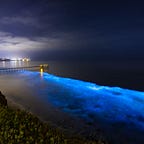The Devastating Implications of Ocean Acidification on Bioluminescence and Why We Need to Do Something About It
The Wonders of Bioluminescence
If you have lived along the Southern California coast as long as I have, then there is a huge chance that during the summer months at night you have spotted this enchanting neon glow emitted by the ocean waves. This glowing effect is known as bioluminescence, a phenomenon that has been witnessed in several marine environments. Bioluminescence involves a unique chemical reaction that occurs within the body of marine organisms which results in the production and emission of light. Let’s take a closer look at this chemical reaction. The main components of the reaction require the oxidation of luciferin, an organic substance, and the addition of the catalyzing enzyme luciferase (6). It’s interesting to see how a fairly simple chemical reaction such as this can create by far one of the most beautiful sights along the California coast.
Now for the light to be produced, an external instigator is necessary. This can include the breaking of waves along the sandy shore or even contact between organisms as they are floating in the waters (7). At first glance, this effect may seem to be just a pretty light but it is not! Bioluminescence can be used for a range of vital functions such as defense against predators, reproduction, luring prey, etc (6). As a result, such functions influence the behavioral and ecosystem dynamics within the ocean.
At this point it is pretty obvious how enticing it would be to have this amazing ability. Unfortunately humans can’t naturally obtain this, but this didn’t stop several creatures in the ocean from evolving this luminescent capability over time. In fact, one organism in particular that can be found in the open coastal waters of La Jolla, San Diego are the dinoflagellates Lingulodinium polyedra. Dinoflagellates are unicellular microorganisms that are considered one of the main primary producers and consumers in the marine food web (1,3). These are very tiny organisms but when accumulated in large masses, they can produce this wave of immense light in the midst of a dark ocean.
Bioluminescence is extraordinary to observe and is an advantageous skill for many marine organisms. But what happens when we factor in a detrimental environmental change that has become ominous for many organisms and people? How will bioluminescent creatures be impacted? Will they bear the brunt of the impact and lose their ability or will the organisms remain unscathed from harm?
The Menacing Presence of Ocean Acidification
This detrimental environmental change that has been looming over marine ecosystems is ocean acidification. Due to the burning of fossil fuels over the past decades there have been increases in atmospheric carbon dioxide (CO2). When CO2 comes into contact with the ocean, it subsequently leads to the creation of more hydronium ions present in the water, thus decreasing the pH of the ocean (2). There have been several studies conducted on ocean acidification and the majority have found that this acidity change can lead to various decreases in growth, development, survival, calcification and abundance of many different marine organisms (4,5).
This type of information is an eyeopener on how ocean acidification will continue to have detrimental impacts on the ocean and its marine ecosystems. With this in mind, there is a possibility that these acidity changes can disturb the intensity of bioluminescence emitted by marine organisms. As a result, the organism’s interactions with its surrounding environment can be altered, thus hindering its survival in the massive ocean it resides in.
Call To Action
So…what now? Well at this point, researchers have an understanding that the ocean has been undergoing chemical changes for decades because of human-induced activities. Consequently, marine ecosystems are paying the price. Although many don’t acknowledge the change that’s occurring, it’s essential that they do. I may be forward in saying this but people tend to only start caring about ocean acidification once it directly affects them, but as humans, we must stray away from this mindset and concentrate on helping our marine environment. Individuals must acknowledge that the ocean is not a source for humanity’s selfish desires and as humans, it is our job to look after the ocean and its best interest.
The loss of species from ocean acidification can lead to a further reduction in biodiversity and major changes to the ecosystem structure. Being aware of these effects is a must and future research must be done to help create effective plans that can prevent further damage induced by ocean acidification upon marine ecosystems and organism adaptations, such as bioluminescence. This is a call to action to pursue further research on the effect of ocean acidification on the light intensity produced by organisms undergoing bioluminescence. Doing so will provide new insight into the vitality of bioluminescent creatures and the damaging effects caused by ocean acidification.
Citations: [1] Carty, S., & Parrow, M. W. (2015). Dinoflagellates in Freshwater Algae of North America. Academic press.[2] Doney, S. C., et al. (2009). Ocean acidification: the other CO2 problem. Annual review of marine science. [3] Gómez, F. (2012). A quantitative review of the lifestyle, habitat and trophic diversity of dinoflagellates. Systematics and Biodiversity. [4] Kroeker, K., et al. (2013). Impacts of ocean acidification on marine organisms: Quantifying sensitivities and interaction with warming. [5] Kroeker, K., et al.(2010). Meta‐analysis reveals negative yet variable effects of ocean acidification on marine organisms. [6] Moline M.A., et al. (2010). Bioluminescence in the Sea. Annual Review of Marine Science.[7] Valiadi, M., & Iglesias-Rodriguez, D. (2013). Understanding bioluminescence in dinoflagellates. Microorganisms.
